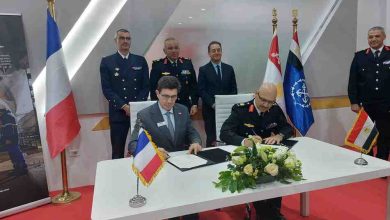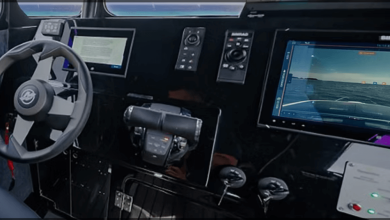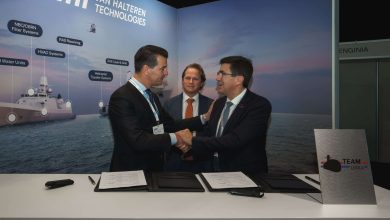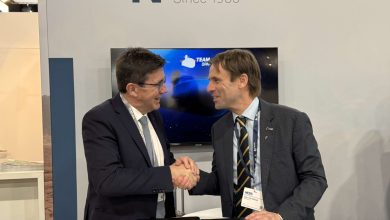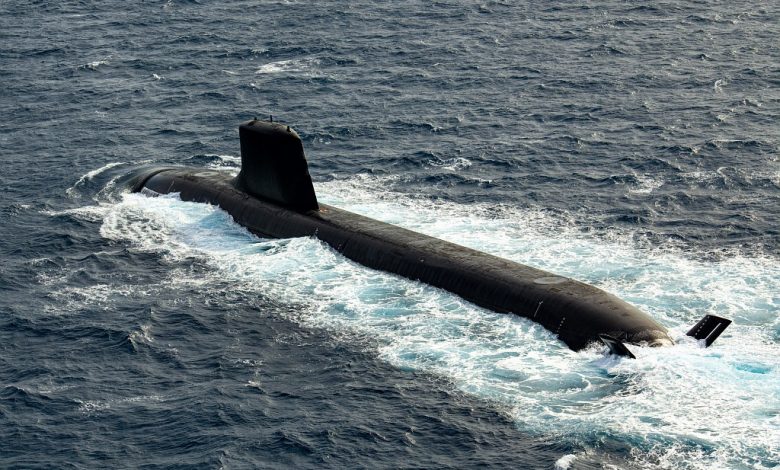
French Defense Procurement Agency Welcomes the Advanced Suffren Submarine from Naval Group
Naval Group officially handed over the Suffren nuclear attack submarine (SSN) to the French Armament Procurement Agency (Direction Générale de l’Armement – DGA) on Friday at the Toulon naval facility.
Designed for the French Navy, the Suffren marks the inaugural unit in a series of six SSNs that will gradually succeed the submarines from the Rubis-class. The handover of the Suffren occurred in the presence of a select group of prominent figures, due to ongoing health safety measures.
Florence Parly, the French Minister of Defense, General François Lecointre, Chief of Staff of the French Armed Forces, Joël Barre, General Delegate for Armament, Admiral Pierre Vandier, Chief of Staff of the French Navy, Victor Salvetti, Director of military applications at the French Alternative Energies and Atomic Energy Commission (CEA), Pierre Eric Pommellet, CEO of Naval Group, and Loïc Rocard, CEO of TechnicAtome, all acknowledged this significant milestone for the Barracuda initiative, alongside various representatives from political, industrial, and military sectors, including crew members.
The delivery of the Suffren represents a crucial achievement for the Barracuda project, which serves as the cornerstone of the French submarine forces extending into the 2060s.
Launched in 1998 by the French Defense Procurement Agency (DGA), the Barracuda initiative revitalizes the submarine segment of the French nuclear deterrent capability, which includes six Rubis-class submarines that were commissioned in the early 1980s. The related development agreement was finalized at the close of 2006. Over a decade of research was necessary to design a submarine that satisfies the operational standards of the French Navy. This initial handover marks the commencement of a trajectory towards the qualification of this new class.
The handover of the six submarines is anticipated to unfold over the next ten years. With a lifespan exceeding 30 years, the Suffren-class submarines will act as the foundation of the French submarine units until at least 2060, establishing them as one of the premier weapon systems of this era.
Pierre Eric Pommellet, CEO of Naval Group, expressed: “What an incredible journey Naval Group has embarked upon with its industrial and governmental allies since the first metal sheet was cut on December 10, 2007, less than a year after the DGA signed the acquisition agreement. The industrial challenges have been ample. I commend the dedication of Naval Group’s design and production teams, TechnicAtome – the main contractor for the onboard nuclear reactor – as well as the DGA, the CEA, and the French Navy. Hundreds of French enterprises – both large and small, with Naval Group at the forefront, have been and remain engaged in the establishment of this program.”
“This initial triumph can only reinforce our collective resolve to deliver the next unit of the Barracuda series, the Duguay-Trouin, in 2022, along with the remaining four submarines by the decade’s conclusion,” he added.
The assembly of the subsequent Barracuda submarines persists at Naval Group in conjunction with our partners, utilizing a diverse range of exceptional expertise in cutting-edge technologies. Among these, the specialized steels, underwater acoustic capabilities, and weapon systems position the SSN Barracuda as one of the most proficient submarines globally.
The Barracuda submarines, equipped with advanced navigation and communication systems and centralized, automated controls, are also more agile and mobile. A significant innovation is the optronic mast, which substitutes the telescopic mast, ensuring superior visual information collection and enhanced sharing among the crew. This feature, coupled with advanced detection capabilities, ensures Barracuda submarines excel in their intelligence operations.
The Barracuda series additionally grants the French Navy a definitive combat advantage; for the first time, it includes deep strike capabilities enabled by MBDA naval cruise missiles (NCM). They also have the ability to launch the Naval Group’s new heavy torpedo F21 and MBDA SM39 missiles. The Barracuda submarines facilitate the covert and improved deployment of Special Forces.
This leap in technology and capabilities is a result of over twenty years of collaborative efforts between Naval Group and hundreds of partners within the European defense industrial and technological framework. A total of 2,500 personnel (including approximately 800 from Naval Group subcontractors) are contributing to the design and production of the Barracuda submarines.
All Naval Group facilities are currently engaged in the development of the next five Barracuda submarines. The second unit, the Duguay-Trouin, will have its sections fully integrated by year-end and is slated for delivery in 2022. The third vessel, the Tourville, is being assembled alongside the Duguay-Trouin. At the Naval Group site in Nantes-Indret, the assembly of the propulsion system and the nuclear boiler module for the fourth submarine, the De Grasse, is also underway. Finally, Naval Group teams have initiated the formation of the initial elements of the hulls for the fifth and sixth submarines, the Rubis and the Casabianca, as well as components for their nuclear boiler modules.
The infrastructure at the Toulon naval base has been upgraded to support this new submarine generation: “We are prepared and very proud to undertake the through-life support of the Suffren in Toulon,” stated Vincent Vimont, Director of the SSN Operational Maintenance Program at Naval Group.
The project commenced with definition studies in 2014 and engaged around 200 individuals from Naval Group and 15 subcontractors. Two additional basins are set to be modernized in the forthcoming years. The teams at the Naval Group Toulon facility, specialized in the through-life support of submarines, have received training on the new specifications for the submarine and the utilization of the newly developed facilities. They are now certified to perform maintenance on the Suffren and her sister vessels.
The trials for the Suffren have been successfully accomplished, ensuring the technological superiority of the French Navy at sea.
“We successfully optimized the sea trials phase within a six-month timeline, including 100 days at sea! In comparison, it took 15 months for the Rubis-class! This marks the first instance a new vessel has been able to sail twice in a continuous month-long period during her sea trials. This demonstrated the submarine’s endurance to our client. To enhance our operational efficiency, we minimized the number of shore trials and optimized sea trials,” remarked Philippe Nezondet, Head of Suffren trials at Naval Group.
The sea trials, supervised by the DGA with the submarine manned by the French Navy, aim to validate the capacities of the Suffren and ensure compliance with specifications in order to qualify the Barracuda submarines. These sea trials constitute an intense validation stage for the onboard systems of a nuclear submarine. The operations conducted progressively across multiple test campaigns have confirmed the vessel’s watertight integrity, maneuverability, and the performance of its combat systems, tactical weaponry, and all high-tech onboard equipment.
These tests culminated in the firing of the SM39 missile on September 23 and the naval cruise missile (NCM) on October 20. The NCM offers a substantial advantage for the Barracuda submarines compared to their predecessors: French submarines can now launch underwater and accurately strike land targets several hundred kilometers away. This newfound capability underscores the technological superiority of French Navy vessels.
Technical specifications of the Suffren-class SSN:
- Surface displacement: 4,600 tons
- Underwater displacement: 5,200 tons
- Length: 99 meters
- Diameter: 8.8 meters
- Armament: naval cruise missiles (NCM), heavy torpedo F21, anti-ship missiles SM39, mine-laying capacity
- Hybrid propulsion: pressurized water reactor derived from the nuclear generators of the Le Triomphant-class SSBN and Charles-de-Gaulle aircraft carriers, two propulsion turbines, two turbine generators, and two electric motors
- Immersion: beyond 300 m.
- Crew: 65 personnel + Special Forces.



